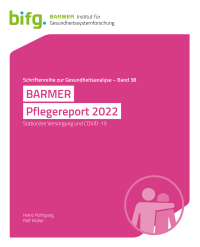
On Tuesday, November 29, the 2022 BARMER Long-Term Care Report was presented in Berlin. Besides a general overview and an evaluation of long-term care policy over the past year, the focus chapter in this year’s Report analyzes the impact of Covid-19 on the nursing home sector. Not only are the effects on the residents and the homes themselves examined, but also the financial effects on long-term care insurance.
Promises made in the Coalition Agreement have so far not yet been fulfilled
The Coalition Agreement was signed just over a year ago, and it included a set of measures for ameliorating the long-term care situation. However, none of these measures have been implemented to this day. As the measures laid out in the Agreement are urgently needed for further development, it can only be hoped that their implementation begins as quickly as possible in the coming year. Otherwise there will not be enough time till the end of the parliamentary term for carrying out the urgently needed, major long-term care reform.
Long-term care dependents in nursing homes bear the brunt of the pandemic
Nursing home residents have been affected directly and indirectly by the pandemic.
In the first wave, to limit the spread of the infection, nursing homes imposed drastic contact restrictions on visitors, volunteers, and in some cases even doctors, therapists and podiatrists. This resulted not only in restricted medical care, but in particular – not least because of isolation and loneliness – in negative effects on the mental health of the residents.
Despite contact restrictions, the share of residents suffering from COVID-19 in the first and second waves was 7-8 times higher than in the whole population, according to extrapolations of the BARMER data. Moreover, as a consequence of the vulnerability of nursing home residents, more than half of those who died with COVID-19 in the first and second waves were nursing home residents. For the years 2020 and 2021 the cumulative share of nursing home residents who died with COVID-19 stood at 45%, while the share of all care dependents among those who died with COVID-19 was 75%. Fatalities with COVID-19 led to a corresponding excess mortality. Compared with the years 2017-2019 there was an excess mortality among nursing home residents of more than 150,000 persons.
At the end of the observation period, the number of affected residents is still very high. Preparations for new variants of the virus and even more waves are therefore indicated. In order to prevent negative indirect effects, however, contact restriction measures should be dispensed with as far as possible.
Nursing home careworkers are also particularly badly affected
Contact bans in nursing homes, essential hygienic measures – including the compulsory wearing of masks for staff members – as well as staff shortages due to the pandemic, have exacerbated the situation for careworkers. They also had to carry out emotional work – which is normally done by relatives – and under more difficult conditions. As there was initially not enough personal protective equipment available, and the nature of their work made it almost impossible for them to keep their distance, they were particularly affected by the pandemic.
Consequently, sick leave figures for care workers in nursing homes in the first two waves were about five times higher than for employees in other economic sectors. In the third and fourth waves, however, figures for sick leave in all sectors levelled out again.
In order to be prepared for further COVID-19 waves and future pandemics, it is essential to recruit more employees in nursing homes expeditiously and in line with the new procedure for the standardized calculation of staffing requirements in long-term care. Only in this way can a downwards spiral of excessive demands on staff and higher sick leave figures be avoided.
After steep declines in the first two waves, the utilization of formal long-term care services has normalized again.
During the first two pandemic waves, some care dependents and their relatives dispensed with the use of formal care services out of fear of infection. Nursing homes also had to reduce their services, especially as they lacked the staff. There was a heavy drop of around 50% in demand for short-term care in the first wave. In residential long-term care the effect was primarily noticeable in a decline of around 40% in moves from home care to residential care. As full-time home residents usually have no chance of moving back into their old domestic settings, the effect of the pandemic on nursing home residents was correspondingly smaller.
The introduction of vaccinations was likely a decisive factor in the return, in summer 2021, of new arrivals in full-time nursing homes and the use of day care to pre-pandemic figures. However, the downward trend until December 2021 indicates that new waves may again give rise to reduced utilization.
Social insurance is again misused for financing obligations that concern society as a whole
It was laid down in the Coalition Agreement that pandemic-related additional costs of long-term care insurance would be financed through taxes.
In actual fact, the additional costs for rescue packages for long-term care facilities, for the prescribed POC-Antigen tests and for the Corona nursing care premium, accrued to 9.2 billion euros by the end of the first quarter of 2022, but were only offset by federal subsidies, financed through taxes, to the amount of four billion euros. This leaves the long-term care insurance fund with a deficit of 5.2 billion euros, and that is without taking the corona-related extra expenditure for the remaining three quarters of 2022 into account. As yet, therefore, this promise, made in the Coalition Agreement, has not been fulfilled, and obligations that concern society as a whole are again being subsidized through contributions.
Other financial risks render a financial reform at the beginnning of 2023 inevitable. It is to be hoped, when it happens, that the obligation to pay back the above-named credits will be waived and that corona-related costs will be fully tax-financed – as laid out in the Coalition Agreement.
Downloads (all in German):
BARMER Long-Term Care Report 2022
Statement by Prof. Rothgang at the Press Conference
Slide presentation by Prof. Rothgang at the Press Conference
Contact:
Prof. Dr. Heinz Rothgang
SOCIUM Research Center on Inequality and Social Policy
Mary-Somerville-Straße 3
28359 Bremen
Phone: +49 421 218-58557
E-Mail: rothgang@uni-bremen.de
Dr. rer. pol. Rolf Müller
SOCIUM Research Center on Inequality and Social Policy
Mary-Somerville-Straße 3
28359 Bremen
Phone: +49 421 218-58554
E-Mail: rmint@uni-bremen.de











